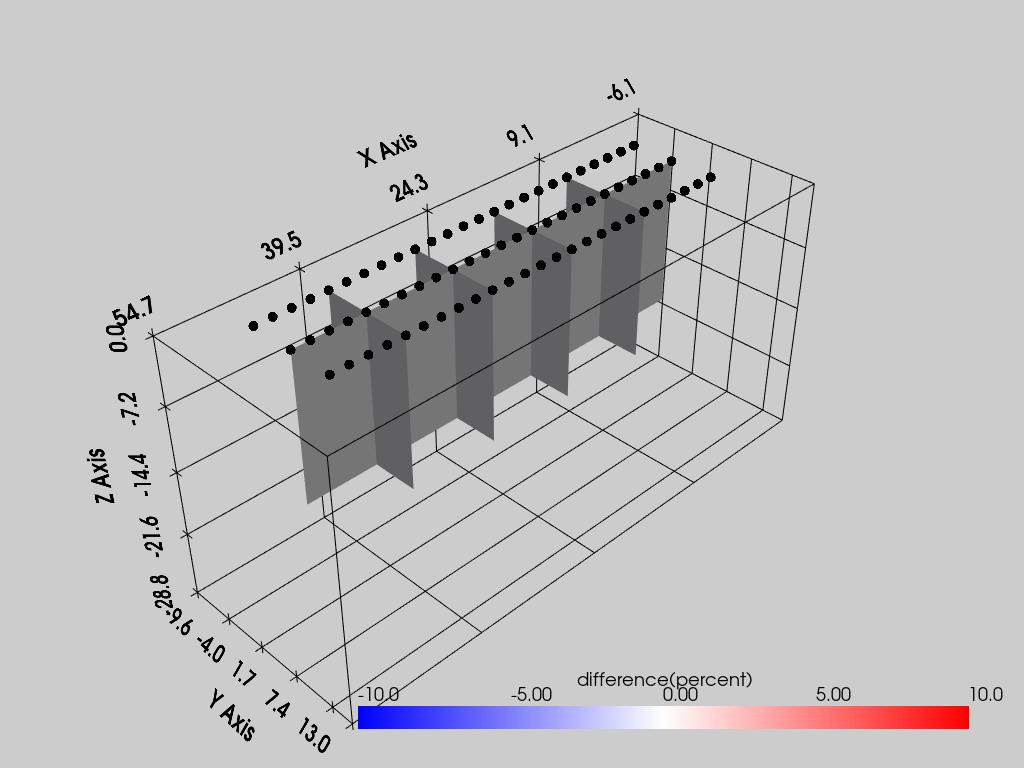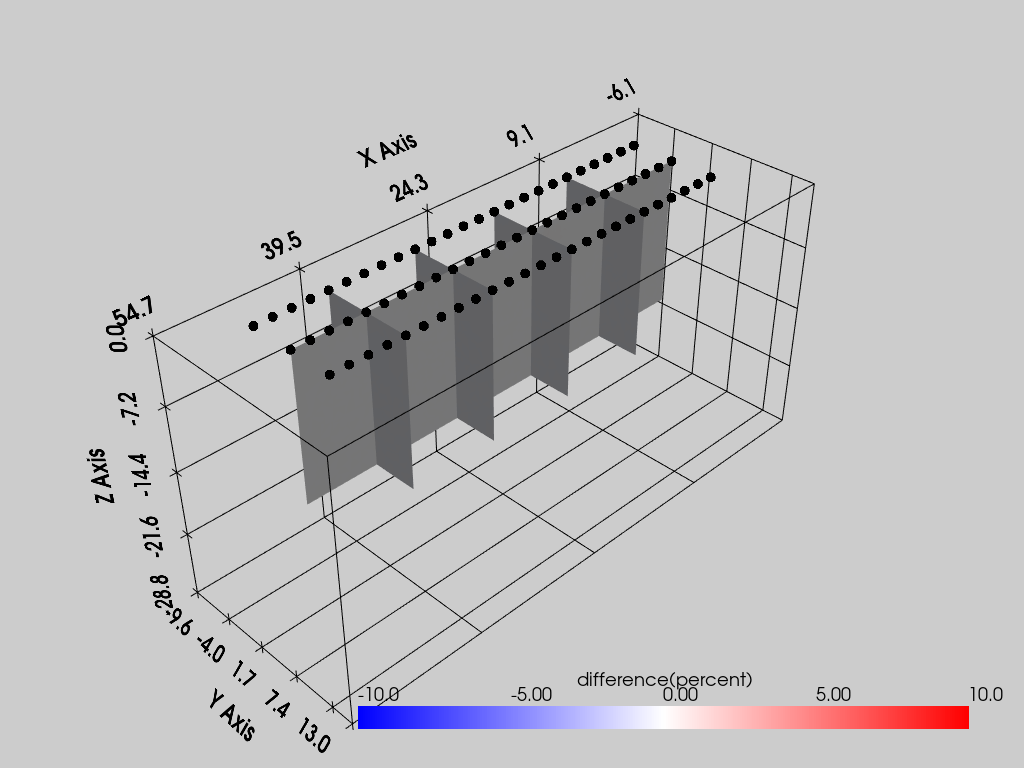Time-lapse 3D survey
To invert time-lapse survey there are two modes: reg_mode == 1 or reg_mode == 2 (see R3t documentation). - reg_mode == 1 is refered to as ‘background constrained’ inversion where the subsequente survey are penalized from departure from the reference survey. - reg_mode == 2 (default in ResIPy) is refered to as ‘difference inversion’ but, for 3D, this requires to modify the protocol.dat to compute \(d - d_0 + f(m_0)\) where \(d_0\) is the observed transfer resitance of the
reference survey, \(d\) is the observed transfer resistances of the survey to be inverted, \(f(m_0)\) represent the forward response (in terms of transfer resistances) of the inverted reference model. While R2 and cR2 do d-d0+f(m0) internally, R3t does not. But ResIPy has this build-in, hence no special initiative is required from the user if you want to use reg_mode == 2. You will see the --- Computing d-d0+f(m0) ---- when calling Project.invert().
[1]:
import warnings
warnings.filterwarnings('ignore')
import os
import sys
sys.path.append((os.path.relpath('../src'))) # add here the relative path of the API folder
testdir = '../src/examples/'
from resipy import Project
import pyvista as pv # for 3D plots
import numpy as np # to specify np.infty
API path = /media/jkl/data/phd/resipy/src/resipy
ResIPy version = 3.4.6
cR2.exe found and up to date.
R3t.exe found and up to date.
cR3t.exe found and up to date.
[2]:
# difference inversion - see d-d0+f(m0) in the log
k = Project(typ='R3t')
k.createTimeLapseSurvey([testdir + 'dc-3d-timelapse-protocol/data/protocol3D-1.dat',
testdir + 'dc-3d-timelapse-protocol/data/protocol3D-2.dat'],
ftype='ProtocolDC')
k.importElec(testdir + 'dc-3d-timelapse-protocol/elec/electrodes3D-1.csv')
k.createMesh()
k.invert()
# by default `reg_mode == 2` (difference inversion)
print(k.param['reg_mode'])
Working directory is: /media/jkl/data/phd/resipy/src/resipy
clearing dirname
2/2 imported
Creating tetrahedral mesh...done (62877 elements)
Writing .in file and protocol.dat... Matching quadrupoles between pairs of (background, surveyX) for difference inversion...done in 0.00312s
done
------------ INVERTING REFERENCE SURVEY ---------------
>> R 3 t E R T M o d e l v 2.31 <<
>> Date: 03-12-2023
>> My beautiful 3D survey
>> I n v e r s e S o l u t i o n S e l e c t e d <<
>> A d v a n c e d M e s h I n p u t <<
>> T e t r a h e d r a l E l e m e n t M e s h <<
>> Reading mesh file
>> Determining storage needed for finite element conductance matrix
>> Generating index array for finite element conductance matrix
>> Reading resistivity model from res0.dat
>> L o g - D a t a I n v e r s i o n <<
>> N o r m a l R e g u l a r i s a t i o n <<
>> Memory estimates:
For 1000 measurements the memory needed is: 0.521 Gb
For 2000 measurements the memory needed is: 1.024 Gb
For 5000 measurements the memory needed is: 2.534 Gb
For 10000 measurements the memory needed is: 5.049 Gb
>> Forming roughness matrix
>> Number of measurements read: 644
>> Total Memory required is: 0.342 Gb
Processing frame 1 - output to file f001.dat
Iteration 1
Initial RMS Misfit: 2.61 Number of data ignored: 0
Alpha: 21.523 RMS Misfit: 0.36 Roughness: 5.440
Step length set to 1.000
Final RMS Misfit: 0.36
Final RMS Misfit: 1.01
Solution converged - Outputing results to file
Calculating sensitivity map
End of data: Terminating
>> Program ended normally
----------------- Computing d-d0+f(m0) ---------------
Writing .in file and mesh.dat... done
Writing protocol.dat... done
Running forward model...
>> R 3 t E R T M o d e l v 2.31 <<
>> Date: 03-12-2023
>> My beautiful 3D survey
>> F o r w a r d S o l u t i o n S e l e c t e d <<
>> A d v a n c e d M e s h I n p u t <<
>> T e t r a h e d r a l E l e m e n t M e s h <<
>> Reading mesh file
>> Determining storage needed for finite element conductance matrix
>> Generating index array for finite element conductance matrix
>> Reading resistivity model from resistivity.dat
>> Memory estimates:
For 1000 measurements the memory needed is: 0.011 Gb
For 2000 measurements the memory needed is: 0.011 Gb
For 5000 measurements the memory needed is: 0.011 Gb
For 10000 measurements the memory needed is: 0.012 Gb
>> Number of measurements read: 644
>> Total Memory required is: 0.011 Gb
>> Program ended normally
0/644 reciprocal measurements found.
Forward modelling done.Matching quadrupoles between pairs of (background, surveyX) for difference inversion...done in 0.00214s
--------------------- MAIN INVERSION ------------------
/media/jkl/data/phd/resipy/pyenv/lib/python3.10/site-packages/numpy/lib/function_base.py:2458: DeprecationWarning: Conversion of an array with ndim > 0 to a scalar is deprecated, and will error in future. Ensure you extract a single element from your array before performing this operation. (Deprecated NumPy 1.25.)
res = asanyarray(outputs, dtype=otypes[0])
>> R 3 t E R T M o d e l v 2.31 <<
>> Date: 03-12-2023
>> My beautiful 3D survey
>> I n v e r s e S o l u t i o n S e l e c t e d <<
>> A d v a n c e d M e s h I n p u t <<
>> T e t r a h e d r a l E l e m e n t M e s h <<
>> Reading mesh file
>> Determining storage needed for finite element conductance matrix
>> Generating index array for finite element conductance matrix
>> Reading resistivity model from Start_res.dat
>> L o g - D a t a I n v e r s i o n <<
>> D i f f e r e n c e R e g u l a r i s a t i o n <<
>> Memory estimates:
For 1000 measurements the memory needed is: 0.521 Gb
For 2000 measurements the memory needed is: 1.024 Gb
For 5000 measurements the memory needed is: 2.534 Gb
For 10000 measurements the memory needed is: 5.049 Gb
>> Forming roughness matrix
>> Number of measurements read: 644
>> Total Memory required is: 0.342 Gb
Processing frame 1 - output to file f001.dat
Iteration 1
Initial RMS Misfit: 0.00 Number of data ignored: 0
FATAL: Initial RMS shows solution !
Your error estimates (a_wgt and b_wgt are too high)
End of data: Terminating
>> Program ended normally
2/2 results parsed (1 ok; 1 failed)
2
[3]:
k.showResults(index=1, pvslices=[[10,20,30,40],[0],[]], attr='difference(percent)',
color_map='bwr', vmin=-10, vmax=10)

In background constrained inversion (reg_mode == 1), the difference(percent) attribute is not computed by R3t. In order to have it computed by ResIPy, it is needed to tell R3t to output the full mesh (so that ResIPy can match the mesh elements between reference and other surveys). To do this set Project.param['num_xy_poly'] = 0 and set zmin and zmax to \(-\infty\) and \(+\infty\) respectively, just before Project.invert(). If you don’t change that, R3t will crop
the mesh by default and ResIPy will output a message saying it couldn’t compute ‘difference(percent)’.
Note that setting num_xy_poly to 0 and changing zmin/zmax does not change the vizualisation. It just changes the .vtk and .dat files produced by R3t.
[4]:
# background constrained - see d-d0+f(m0) in the log
k = Project(typ='R3t')
k.createTimeLapseSurvey([testdir + 'dc-3d-timelapse-protocol/data/protocol3D-1.dat',
testdir + 'dc-3d-timelapse-protocol/data/protocol3D-2.dat'],
ftype='ProtocolDC')
k.importElec(testdir + 'dc-3d-timelapse-protocol/elec/electrodes3D-1.csv')
k.createMesh()
k.param['reg_mode'] = 1
k.param['num_xy_poly'] = 0 # tells R3t to no crop the mesh
k.param['zmin'] = -np.inf
k.param['zmax'] = np.inf
k.invert()
Working directory is: /media/jkl/data/phd/resipy/src/resipy
clearing dirname
2/2 imported
Creating tetrahedral mesh...done (62877 elements)
Writing .in file and protocol.dat... done
------------ INVERTING REFERENCE SURVEY ---------------
>> R 3 t E R T M o d e l v 2.31 <<
>> Date: 03-12-2023
>> My beautiful 3D survey
>> I n v e r s e S o l u t i o n S e l e c t e d <<
>> A d v a n c e d M e s h I n p u t <<
>> T e t r a h e d r a l E l e m e n t M e s h <<
>> Reading mesh file
>> Determining storage needed for finite element conductance matrix
>> Generating index array for finite element conductance matrix
>> Reading resistivity model from res0.dat
>> L o g - D a t a I n v e r s i o n <<
>> N o r m a l R e g u l a r i s a t i o n <<
>> Memory estimates:
For 1000 measurements the memory needed is: 0.521 Gb
For 2000 measurements the memory needed is: 1.024 Gb
For 5000 measurements the memory needed is: 2.534 Gb
For 10000 measurements the memory needed is: 5.049 Gb
>> Forming roughness matrix
>> Number of measurements read: 644
>> Total Memory required is: 0.342 Gb
Processing frame 1 - output to file f001.dat
Iteration 1
Initial RMS Misfit: 2.61 Number of data ignored: 0
Alpha: 21.523 RMS Misfit: 0.36 Roughness: 5.440
Step length set to 1.000
Final RMS Misfit: 0.36
Final RMS Misfit: 1.01
Solution converged - Outputing results to file
Calculating sensitivity map
End of data: Terminating
>> Program ended normally
--------------------- MAIN INVERSION ------------------
>> R 3 t E R T M o d e l v 2.31 <<
>> Date: 03-12-2023
>> My beautiful 3D survey
>> I n v e r s e S o l u t i o n S e l e c t e d <<
>> A d v a n c e d M e s h I n p u t <<
>> T e t r a h e d r a l E l e m e n t M e s h <<
>> Reading mesh file
>> Determining storage needed for finite element conductance matrix
>> Generating index array for finite element conductance matrix
>> Reading resistivity model from Start_res.dat
>> L o g - D a t a I n v e r s i o n <<
>> B a c k g r o u n d R e g u l a r i s a t i o n <<
>> Memory estimates:
For 1000 measurements the memory needed is: 0.521 Gb
For 2000 measurements the memory needed is: 1.024 Gb
For 5000 measurements the memory needed is: 2.534 Gb
For 10000 measurements the memory needed is: 5.049 Gb
>> Forming roughness matrix
>> Number of measurements read: 644
>> Total Memory required is: 0.342 Gb
Processing frame 1 - output to file f001.dat
Iteration 1
Initial RMS Misfit: 1.01 Number of data ignored: 0
Alpha: 21.065 RMS Misfit: 0.69 Roughness: 4.546
Step length set to 1.000
Final RMS Misfit: 0.69
Final RMS Misfit: 1.00
Solution converged - Outputing results to file
Calculating sensitivity map
End of data: Terminating
>> Program ended normally
2/2 results parsed (2 ok; 0 failed)
[5]:
k.showResults(index=1, pvslices=[[10,20,30,40],[0],[]], attr='difference(percent)',
color_map='bwr', vmin=-10, vmax=10)

Note that the two outputs are slightly different. With the difference inversion (reg_mode == 2) being smoother thant the background constrained (reg_mode == 1). Indeed, in this last one, we haven’t inverted the differences in resistivity and the difference(percent) argument has been computed afterwards by ResIPy.
[ ]: